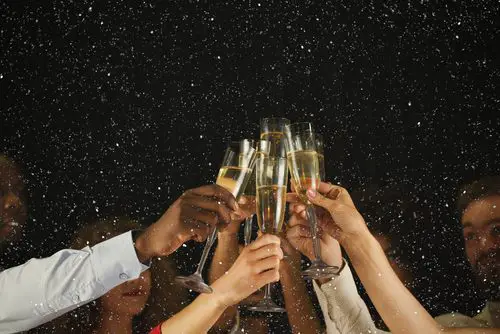Thousands of us will be toasting the New Year with the best that we have to offer but did you know that the first toast on record was in England in 450 AD? It was given at a huge feast by British King Vortigen to his Saxon allies.
Toasting has its roots in ancient Greece when people poured an offering of wine to the gods. However there is a sinister side to this as one way of disposing of a political rival was to slip poison into the wine.
The solution to this problem was for the host to take the first drink after the wine was poured; if he didn’t keel over, the guests could be assured the wine was safe for them to drink too. This is where the notion of “drinking to one’s health” originates from!
The word “toast” comes from the Roman practice of placing a piece of burnt toast in the wine glass. This was a way of removing undesirable flavours from the wine (which could often be vinegary) – the burnt crust acted like a filter as the charcoal absorbed unpleasant odours and tastes.
We raise our glasses and clink them as during the 17th century, it was believed that the bell-like noise of clinking glass would banish the devil. The 18th century brought the position of the “toastmaster”, whose duties included proposing and announcing toasts, making sure all toasters were given a chance to make his/her contribution.
Once all the guests had been toasted (and it was a deadly insult to omit anyone) then absent friends and celebrated beauties would be toasted. The phrase “the toast of the town” dates back to this point and to this custom.
If you were raising a toast back in those days it would have been with a good claret and I can recommend a 21st century one that would be perfect to celebrate with: Chateau Roc de Levraut 2009 (£8.35). We had this over Christmas and it really is a lovely wine.
Roc de Levraut is regularly an award winning wine and is produced by Remi and Roger Ballarin, who also own Chateaux Loyasson and Vieux Balestard. They are the third generation to run the Roc de Levraut. The family purchased the chateau in the 1930s and back then the work was was carried out with a pair of oxen.
Today the Ballarins employ sustainable agriculture alongside modern oenology to respect the land and the grapes. The chateau vineyards lie near Sauveterre de Guyenne – Guyenne being the historic Duchy of Guyenne (the old name for Aquitaine) that was once under English rule for more than 300 years.
The Roc de Levraut 2009 is a Bordeaux Supérieur and wines from this AOC have stricter production norms. They are produced from selected vineyard plots, older vines, smaller yields and the producer must age the wines a minimum of 12 months before selling them. As a result, these wines are generally more complex and have a better ageing potential.
This is a wine to be enjoyed with food – it is velvety smooth with well integrated tannins and has flavours of blackcurrant, vanilla, liquorice, redcurrant and cherry. Try it with braised beef recipes such as osso bucco, steak a la bordelaise as well as game, duck and roast pork.
Cheers! Wishing you a very Happy New Year from us all at Bordeaux Undiscovered and Interest in Wine.

